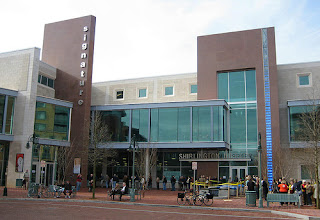This week’s column was inspired by a recent trip to Arlington County. Squiring me around their remarkable community, Arlington officials explained how they approach local development and re-development. I was especially attuned to anything that might shed light on a notion frequently expressed by commenters in this blog: the idea that increased density necessarily translates into greater traffic congestion.
Arlington irrefutably proves otherwise. Poorly planned density may aggravate traffic conditions, but well-planned density can have quite the opposite effect. All one has to do is visit the high-density development around Arlington’s Metro stops to see the proof of that. For all the retail, the high-rise offices and the apartment/condo complexes, the streets around Clarendon station are are freer of traffic than any suburban commercial corridor. The traffic statistics convey the same message.
That may be so, skeptics may say, but Arlington has a huge advantage that most other Virginia localities do not: a heavy rail system largely paid for by someone else. Maybe Arlington escaped the density/congestion trap, but no one else (with the possible exception of Fairfax County) can afford to build a Metro line. Arlington is the exception that proves the rule.
Board Chairman Paul Ferguson has heard that argument, too, and in refutation, he points to the re-development that’s taking place in the Shirlington Town Center — an emerging “urban village” that has no Metro station. Shirlington, he says, is a model that can be replicated in any metropolitan area in Virginia.
Some of the tools used by Arlington planners are known to anyone who reads this blog: Greater density, finely grained mixed uses, and special care in the design of pedestrian-friendly streetscapes. Arlington planners are big believers in narrow streets, wide sidewalks, plazas and other small public spaces, and ground-level retail in large office and apartment buildings — whatever it takes to avoid presenting a blank wall to the sidewalk.
But pedestrian-friendly streetscapes are not the entire solution. Vibrant communities should not just avoid dead spaces, they should avoid dead times. Arlington planners envision a town center that’s jumping 24/7. Well, maybe not 24/7, but definitely 18/7. The trick, which seems to be working, is loading up the town center with major traffic generators including a quality urban grocery store (though with a smaller, urban footprint), a theater and a public library. The formula seems to be working. Shirlington is a happening place.
My visit to Shirlington and its library, which is housed in the same building as the popular Signature Theater, prompted a closer look at the role of libraries in defining human settlement patterns. Sadly, I found that an otherwise marvellous new facility in my Henrico County neighborhood reinforces the community’s old auto-centric habits. An opportunity to create enormous added economic value was lost. In today’s column, “Libraries as Liberators,” I explore what different communities are doing — or not doing — to capture libraries’ phenomenal economic value for the public good.


Leave a Reply
You must be logged in to post a comment.